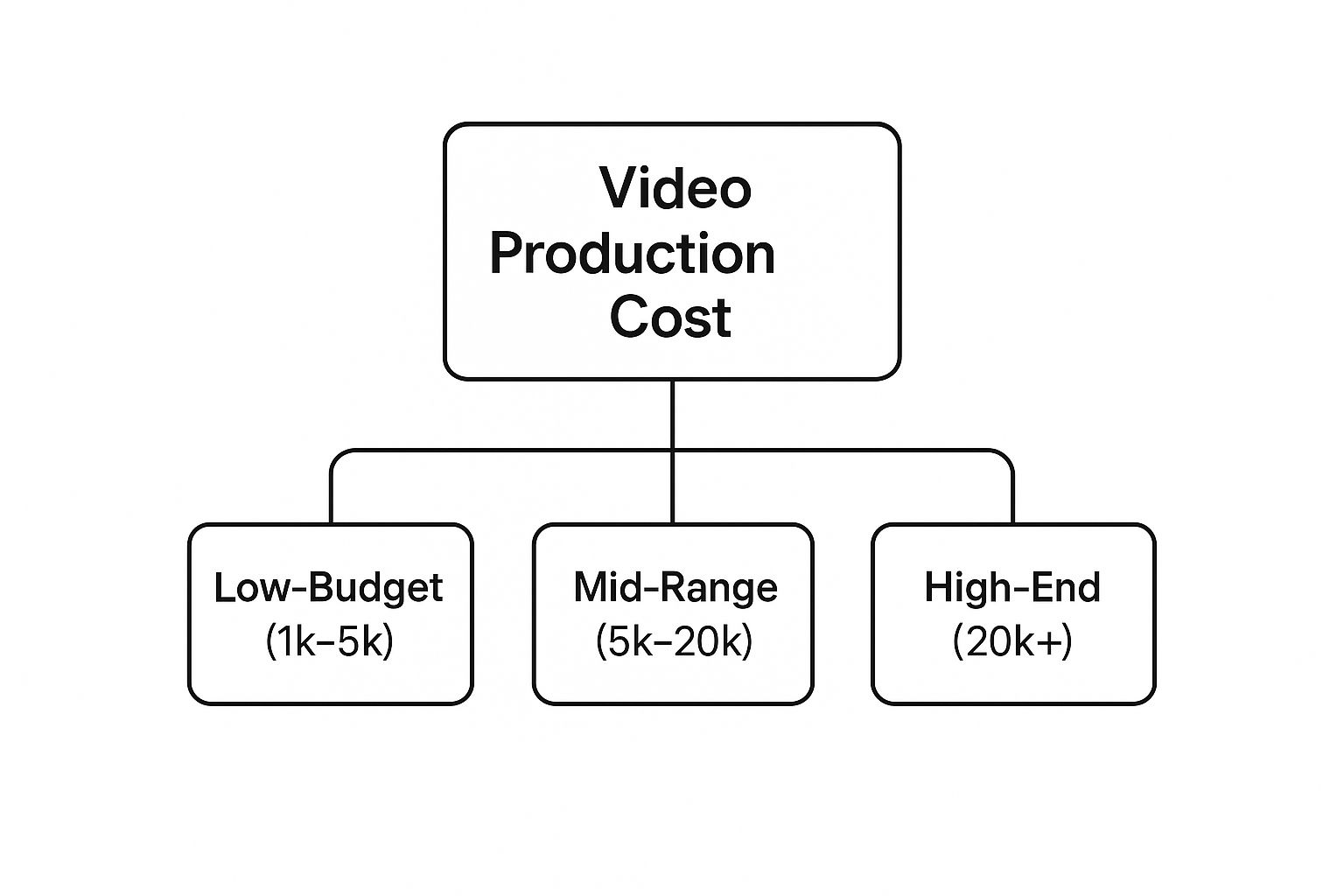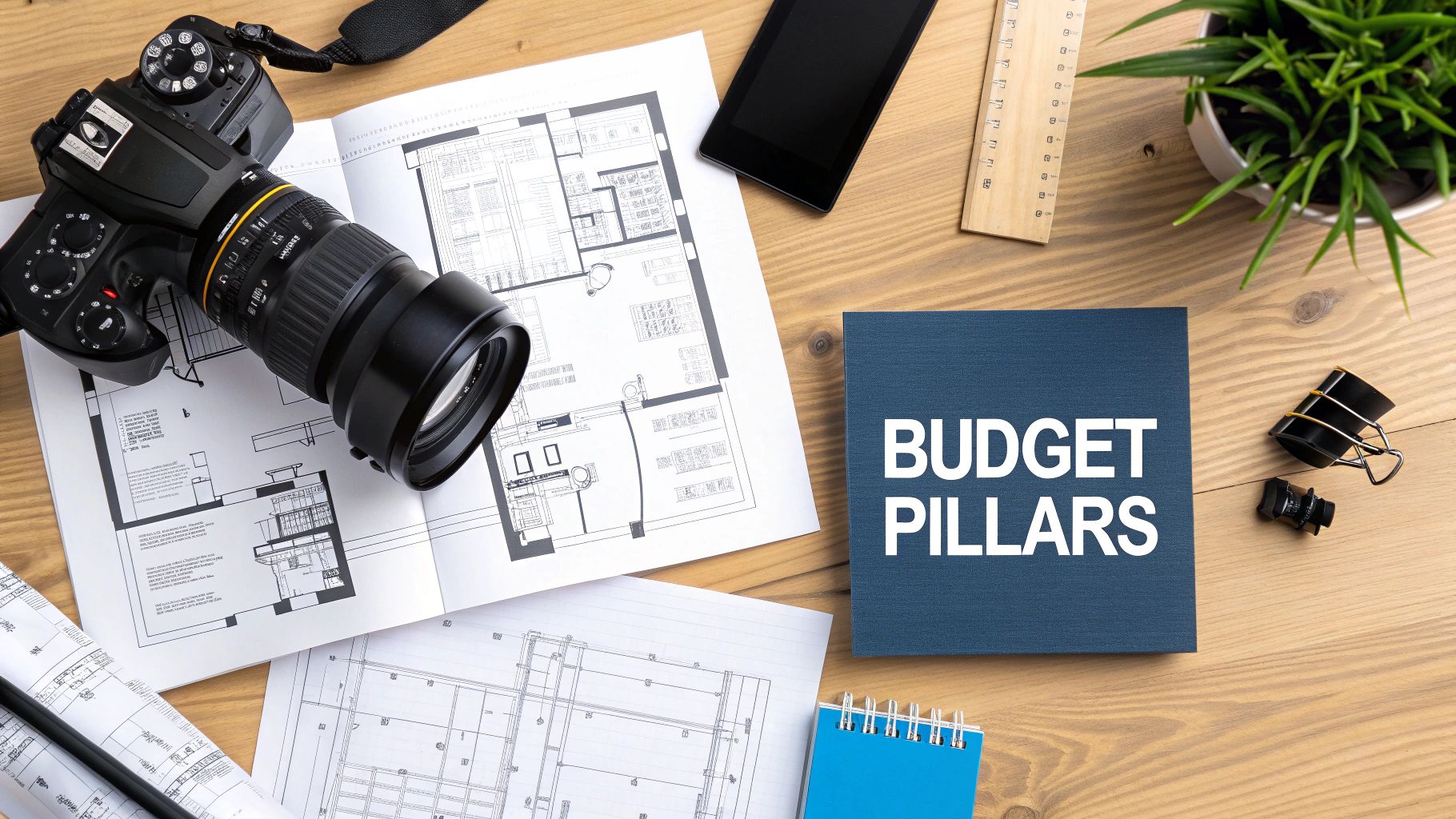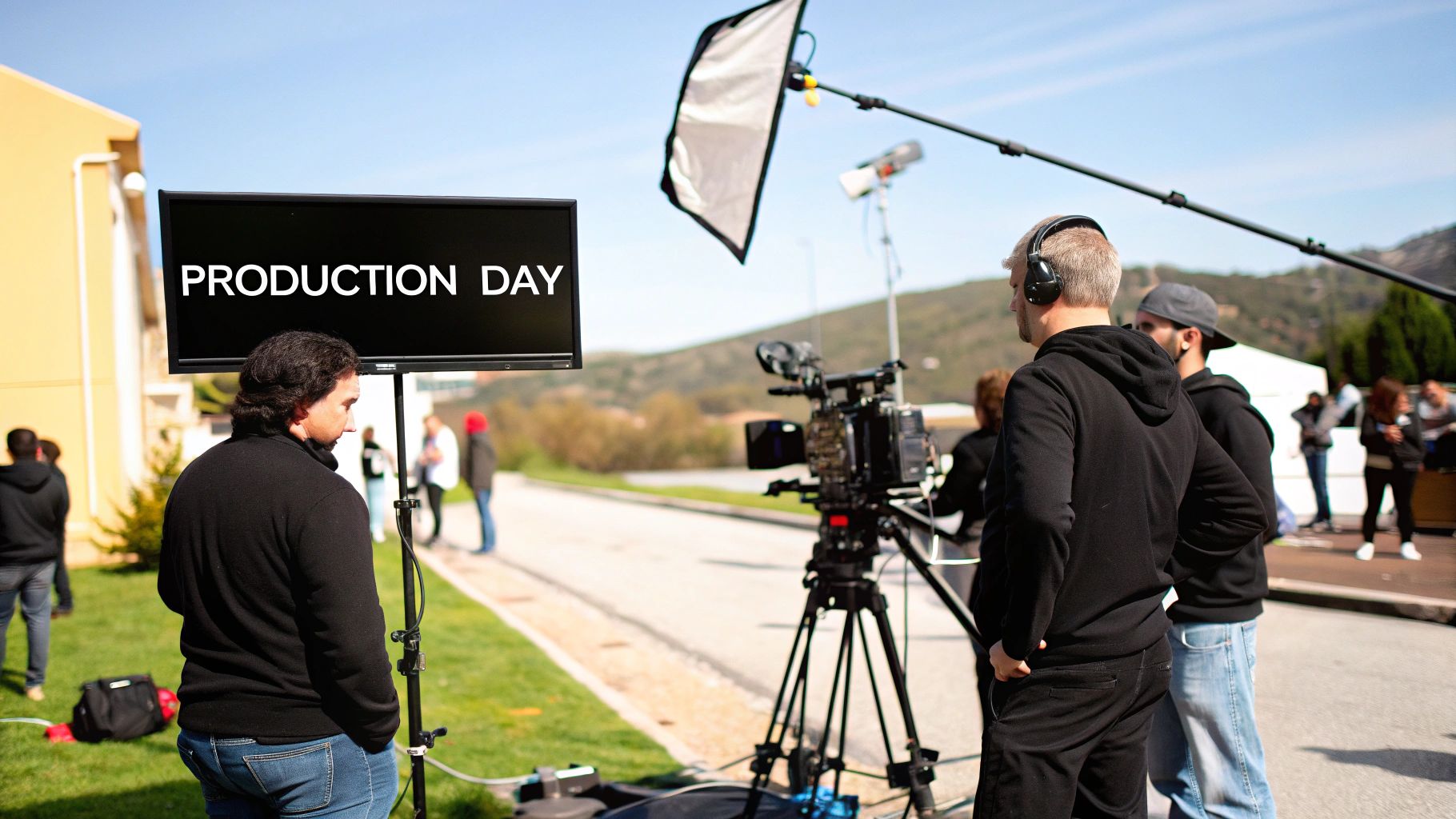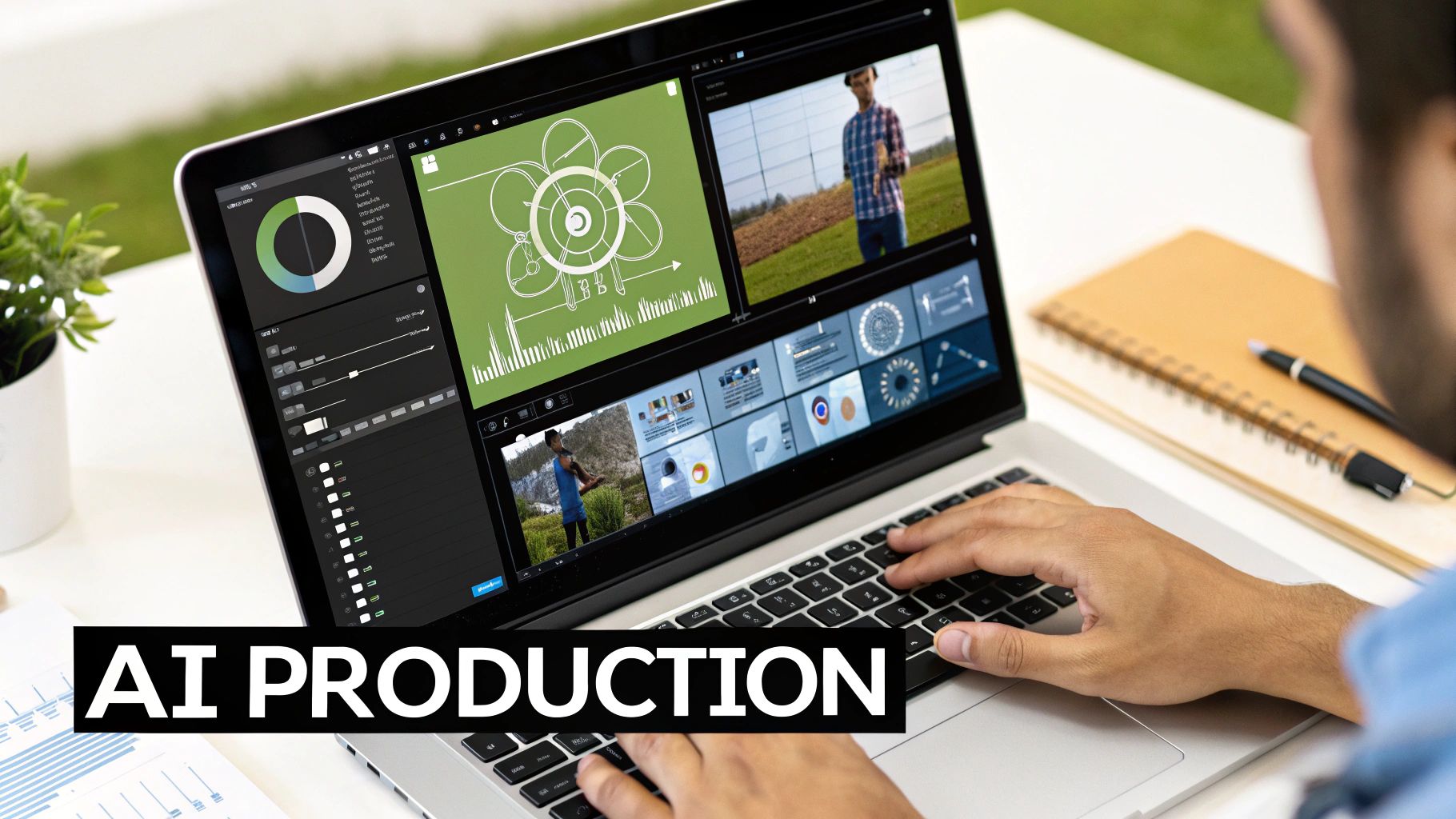So, you want to make a video. One of the first questions that pops into your head is probably, "How much is this going to cost?"
The honest answer? It can be anything from $1,000 for a simple, no-frills project to over $50,000 for a high-end commercial that looks like it belongs on TV. The final price tag really boils down to your project's complexity, the talent you bring on board, and the level of quality you're aiming for.
Understanding Your Video Production Investment
Trying to budget for a video can feel a bit like trying to price a car without knowing if you're looking at a basic sedan or a luxury sports car. They'll both get you from A to B, but the experience—and the cost—are worlds apart. The same logic applies to video production. That final number is a direct reflection of the creative vision, the resources needed, and the expertise required to actually pull it off.
This is where a lot of businesses get stuck. Without a clear idea of where the money goes, it's tough to know if you're getting a fair quote or how to plan your marketing budget. This guide is here to pull back the curtain and demystify the numbers, showing you exactly what drives costs up or down.
The infographic below gives you a quick visual on the three main tiers of video production, helping you see where your project might land.

As you can see, costs scale up pretty quickly as you add more complexity and polish, moving from a straightforward setup to a much more involved, multi-day shoot.
To get a clearer picture of what you might spend, let's break down the different quality tiers. Each level offers different capabilities and is a good fit for specific marketing goals. Thinking about it this way helps you match your budget to your objectives.
Estimated Video Production Cost by Quality Level
This table gives a quick snapshot of what you can expect to invest at different levels of production. It's a handy reference for figuring out a realistic starting point for your budget.
| Quality Tier | Typical Cost Range | Best For |
|---|---|---|
| Low-Budget | $1,000 – $5,000 | Simple social media clips, basic testimonials, or internal training videos. |
| Mid-Range | $5,000 – $20,000 | High-quality promotional videos, company culture stories, and detailed product demos. |
| High-End | $20,000+ | Brand commercials, cinematic brand films, and large-scale marketing campaigns. |
These ranges aren't set in stone, of course, but they provide a solid framework for what's possible at each investment level.
Why Do the Prices Vary So Much?
So, what's behind the huge price gaps? It really comes down to three things: labor, equipment, and time.
Think about it: a one-day shoot with a two-person crew is just fundamentally cheaper than a three-day shoot with a full team—director, cinematographer, sound engineer, actors, the works.
On top of that, the type of video makes a big difference. For instance, creating engaging social content has its own set of rules and costs. Diving into a complete guide to social video production can show you how platform-specific needs really shape the budget.
Ultimately, every dollar has a job to do in the creative process. In the next sections, we'll break down the costs phase by phase, so you can build a budget that actually works for you and delivers the results you’re after.
The Three Pillars of Your Video Budget

To really get a handle on a video production cost breakdown, you have to start thinking like a producer. Every single project, no matter how big or small, rests on three core phases: Pre-Production, Production, and Post-Production. Each stage has its own checklist of tasks and, you guessed it, its own set of costs that all roll up into the final number.
Think of it like building a house. You wouldn't just start throwing up walls without a solid blueprint, right? And you definitely wouldn't move in before the paint is dry and the lights work. Video is exactly the same. Cutting corners or rushing a phase is a surefire way to run into expensive problems later.
Let's pull back the curtain on how your budget gets sliced up across these three critical pillars.
Pre-Production: The Strategic Blueprint
This is where the magic begins—on paper. Pre-production is all about planning. It’s where your video gets built out completely before a single camera starts rolling. Honestly, this is the most important stage for keeping your budget in check, because every decision made here creates a ripple effect down the line.
Great pre-production means fewer surprises, no costly reshoots, and a team that’s perfectly in sync with the creative vision. This phase typically eats up about 20-25% of the total budget.
Here’s what’s happening behind the scenes:
- Concept & Strategy: Nailing down the "why" behind your video. Who's it for? What's the core message? What's the creative hook?
- Scriptwriting: Putting words to the vision. This is the narrative, the dialogue, and any on-screen text that will drive the story forward.
- Storyboarding & Shot Lists: The visual game plan. We’re talking scene-by-scene sketches that map out camera angles, compositions, and the flow of the action.
- Casting: Finding the right faces and voices for the project, whether that’s professional actors, voice-over artists, or internal experts.
- Location Scouting: Pinpointing and locking down the perfect spots to film, which can often involve permits, fees, and logistics.
A solid plan here is the difference between a smooth, efficient shoot and a chaotic one that blows the budget. In a lot of ways, this mirrors the early steps of any good marketing budget planning, where a little foresight goes a long, long way.
Production: Bringing the Vision to Life
And… action! This is shoot day. Production is the "construction" phase where all that careful planning gets turned into actual footage. It’s usually the most intense part of the process and often represents the biggest chunk of your investment.
Production is where the tangible expenses really start to add up. Every person on set, every piece of gear, and every hour of filming hits the bottom line directly. This phase typically consumes 50-60% of the total video budget.
This is when you're paying for the crew, the gear, and the talent to capture everything you need. The key costs here include:
- Director & Crew: The day rates for the whole team—the director, cinematographer, sound engineer, lighting experts (gaffers), and everyone else needed to make it happen.
- Cast & Talent: Paying actors, presenters, or interviewees for their time on set.
- Equipment Rental: The cameras, lenses, lights, microphones, and any specialty gear like drones or Steadicams.
- Location Fees & Logistics: The cost to use a studio or location, plus things like transportation and catering to keep the cast and crew moving.
- Set Design & Props: Building the world. This covers everything from backgrounds and furniture to any specific props the script calls for.
The scale here can swing wildly. A simple interview might just need a three-person crew for a half-day. A full-blown commercial? You could be looking at dozens of people over several days.
Post-Production: The Final Polish
Once filming wraps, all that raw footage gets handed off to the post-production crew. This is the "interior design" stage. It’s where editors, sound designers, and visual artists assemble all the pieces into a slick, cohesive final video. Skimping on this part can completely undermine all the hard work that came before it.
Post-production usually accounts for the final 20-25% of the budget. It's where the story is sharpened and the real magic happens. The main expenses are:
- Video Editing: Weaving the narrative together by selecting the best takes, setting the pace, and structuring the story.
- Color Grading: Fine-tuning the color and tone of every shot to create a specific mood and ensure the look is consistent from start to finish.
- Sound Design & Mixing: Cleaning up audio, adding sound effects, and mixing in music to create a rich, immersive soundscape.
- Motion Graphics & VFX: Adding in any animated text, logos, or more complex visual effects to enhance the story.
- Music Licensing: Securing the rights to use background music, which can range from affordable stock tracks to a custom-composed score.
Each of these pillars is non-negotiable. Understanding how they fit together gives you a clear, predictable roadmap for any video production cost breakdown, helping you budget smart and put your money where it matters most.
Deconstructing Pre-Production Expenses
The success of your video is often decided long before anyone yells "action!" This is the pre-production stage, where your vision gets translated into an actual, workable plan and your budget really begins to take shape.
Think of it as the architectural blueprint for a house. You wouldn't just start building without one, right? Skipping this step leads to costly mistakes, blown timelines, and a final product that just feels shaky.
Proper planning here usually accounts for about 20-25% of your total budget, but its impact on the final video production cost breakdown is massive. A solid pre-production phase is your best defense against expensive reshoots, chaotic production days, and wasted money. It's the ultimate form of project insurance.
Let’s pull back the curtain on the specific costs that define this critical planning stage.
Concept Development and Scriptwriting
Every great video starts with a powerful idea. The initial brainstorming and concept development phase is where you nail down your core message, who you're talking to, and the creative angle you'll take. This often involves strategy sessions and research, which means tapping into the time and expertise of creative professionals.
Once the big idea is locked in, the scriptwriting begins. This isn't just about writing down words; it's about building the narrative backbone of your entire video. The cost for this piece is shaped by a few key things:
- Script Length: More minutes on screen means more time writing and developing the story. Simple as that.
- Complexity: A straightforward talking-head script is worlds away from a complex narrative with multiple characters, scenes, and plot twists.
- Revisions: The number of drafts it takes to get the script just right will affect the final price. Pros typically charge per project or by the hour.
A clear, concise, and compelling script is the single most important element in pre-production. It dictates everything that follows, from the shots you’ll need to the talent you’ll hire.
Getting these details buttoned up early is a game-changer. Using a clear framework can save countless hours and prevent wires from getting crossed. For instance, a detailed document like a creative brief template makes sure everyone—from the writer to the director—is on the same page from day one.
Storyboarding and Visual Planning
A script tells the story, but a storyboard shows it. A storyboard is basically a comic strip version of your video, a sequence of drawings that visualizes each shot. It maps out camera angles, character movements, and scene transitions, giving the entire team a clear visual guide to follow on the day of the shoot.
This step is a massive efficiency booster. It eliminates guesswork and ensures the director and cinematographer capture exactly what’s needed, saving precious time and money when the cameras are actually rolling. The cost of storyboarding really depends on:
- Level of Detail: Are we talking simple stick-figure sketches or highly detailed, full-color illustrations? The former is much more affordable.
- Number of Frames: A longer, more intricate video will naturally require more storyboard frames to map everything out.
- Artist’s Rate: Experienced storyboard artists command higher fees, but their ability to work quickly and effectively often makes it a worthwhile investment.
Location Scouting and Casting Talent
Finding the right setting and the right people are two other major pre-production expenses. The perfect location can instantly elevate your video, but it almost always comes with a price tag. Location scouting is the whole process of finding, vetting, and securing places to film.
These costs can include scout fees, travel, and location rental fees, which can run anywhere from a few hundred to several thousand dollars per day. Don't forget, you might also need to budget for permits just to film in public spaces.
At the same time, casting is underway to find the actors, presenters, or voice-over artists who will bring your script to life. This process can involve:
- Casting Director Fees: Hiring a professional to manage the entire casting process from start to finish.
- Audition Expenses: This could include renting a space for auditions and paying for the time of those involved.
- Talent Fees: While the bulk of this is technically a production cost, all the initial negotiations and contracts are hammered out here.
Each of these pre-production steps is a direct investment in a smoother, more cost-effective production. By meticulously planning every last detail, you not only get a better final video but also gain complete control over your video production cost breakdown.
Analyzing Costs on Production Day

This is it—the day where all the planning and prep finally pay off. Production day is when the vision starts to become a reality, and it’s also where a huge chunk of your budget gets spent. This phase typically eats up 50-60% of your total video production cost breakdown, making it the most resource-heavy part of the whole process.
Think of it as the main event. Every single person, every piece of gear, and every hour on set directly adds to the final bill. This is exactly why a rock-solid pre-production plan is so critical; it’s your roadmap to making sure this expensive day runs like a well-oiled machine.
Let’s pull back the curtain on the key expenses you'll see when the cameras start rolling.
Crew and Talent Fees
On production day, your biggest line item will almost always be the people. You simply can’t get a professional result without a skilled crew, and that expertise comes at a price, usually billed as a "day rate." The size of that crew will grow right alongside the complexity of your project.
A simple talking-head interview might just need a three-person team: a Director/Videographer, a Sound Technician, and a Grip to handle the lighting. But a big, multi-location commercial? That could mean a much larger crew with a bunch of highly specialized roles.
Here are some of the key players you might be paying for:
- Director: The creative captain steering the ship, guiding the overall vision and performances.
- Director of Photography (DP): The visual mastermind responsible for the camera work, lighting, and overall aesthetic.
- Sound Mixer: The audio guru dedicated to capturing crystal-clear, high-quality sound.
- Gaffer: The head lighting tech who literally shapes the mood and look of every scene.
- Grip: The hands-on crew member who sets up and manages camera rigs and lighting equipment.
Then you have your talent fees. This covers any on-screen actors, hosts, or interview subjects. Talent rates can swing wildly depending on their experience, public profile, and how big their role is in the project.
Equipment Rentals and Location Costs
Professional video demands professional gear. While some production companies own a lot of their equipment, specialized items are almost always rented. We’re talking about high-end cinema cameras, specific lenses, drones, or sophisticated lighting rigs. The rental cost is tied directly to the creative goals you mapped out in your storyboard.
A basic corporate video might get by with a straightforward camera and lighting package. On the other hand, a cinematic brand film could call for multiple cameras, slick anamorphic lenses for that widescreen look, and a massive lighting setup—all of which send rental costs climbing.
The equipment list is a direct reflection of your project's ambition. A more polished, cinematic look requires more sophisticated—and more expensive—tools to achieve.
Location fees are another big one. Filming in your own office might be free, but shooting in a rented studio, a unique house, or a public space usually comes with fees and permits. These costs can range from a few hundred bucks for a simple spot to thousands per day for a premium location.
Sample Day Rates for Key Production Crew
To give you a real-world feel for where the money goes, here’s a look at what you can expect to pay for key crew members. These are just ballpark figures, of course—rates can shift based on location, experience, and the specific demands of your project. Choosing the right pros is a make-or-break decision, and our guide on hiring a videographer can help you navigate that process.
| Crew Role | Junior Professional Rate (per day) | Senior Professional Rate (per day) |
|---|---|---|
| Director | $700 – $1,200 | $1,500 – $3,000+ |
| Director of Photography | $600 – $1,000 | $1,200 – $2,500+ |
| Sound Mixer | $450 – $700 | $750 – $1,200+ |
| Gaffer | $400 – $650 | $700 – $1,100+ |
As you can see, putting together an experienced team is a serious investment. But their expertise is what keeps your production day efficient and ensures the final footage looks incredible, saving you from the costly nightmare of reshoots down the road.
Unpacking Post-Production and Final Delivery
The cameras have stopped rolling, the set is packed up, and you’ve got hours of raw footage. But you're not at the finish line just yet. Now the real magic begins: post-production. This is where all those individual shots get stitched together into a polished, professional video. It's the final sprint that can make or break your entire investment.
This phase typically eats up 20-25% of your total video production budget, and for good reason. It’s where the story gets sharpened, the mood is set, and every little detail is meticulously refined. Think of it like this: the production crew sourced the best ingredients, and now the post-production team is the master chef who will cook, season, and plate them into a masterpiece.
Cutting corners here is a huge mistake. You'll end up with a final product that feels disjointed or amateur, completely undermining all the hard work that came before it. Let’s break down what goes into turning raw footage into a compelling final video.
The Art and Cost of Video Editing
Video editing is the heart of post-production. This is way more than just cutting and pasting clips together. The editor is a storyteller, weaving together the best takes, setting the rhythm, and building a narrative that flows seamlessly.
The cost for an editor really depends on a few things:
- Footage Length: The more raw footage the editor has to sift through to find those golden moments, the more time—and money—it’s going to take.
- Video Complexity: A simple talking-head interview is a whole different ballgame than a fast-paced commercial with quick cuts, multiple camera angles, and intricate sequences. The more complex, the higher the cost.
- Revisions: How many rounds of feedback will it take to get it perfect? Each new version adds to the timeline and the budget.
Editors usually charge by the hour or a flat rate for the whole project. To get a feel for what to expect, it’s worth looking into typical freelance video editing rates to see how the pros price their craft.
Enhancing the Look and Feel
Once the story is locked in, specialists step in to add those crucial layers of polish. These are the services that take a video from "good" to "great," creating a professional look and an immersive sound experience.
Color Grading: This is the secret sauce. A colorist adjusts the color and tone of every single shot to create a consistent, cinematic mood. It’s what makes footage feel vibrant and emotionally resonant instead of flat and lifeless.
Sound Design and Mixing: You can’t compromise on audio. A sound designer cleans up dialogue, adds sound effects, balances audio levels, and mixes in music to build a rich soundscape that pulls the viewer in. Bad audio will make a video feel cheap, instantly.
Post-production is where you add the professional sheen that audiences expect. Skimping on color grading or sound mixing is like building a luxury car but forgetting to paint it.
Music and Motion Graphics
Music is the emotional engine of your video. It sets the tone and drives the story forward. The cost here can swing wildly depending on what you choose:
- Stock Music: The most budget-friendly route is licensing a track from a stock library. You can find high-quality tracks for anywhere from $50 to $500.
- Custom Score: For a truly unique and tailored feel, you can hire a composer to create an original piece of music. This is a premium choice and can easily run into several thousand dollars.
Then you have motion graphics, which add a dynamic visual layer. This could be anything from animated logos and on-screen text to lower thirds. The cost is all about complexity—a simple text overlay is one thing, but an elaborate animated sequence requires a specialized artist. Each of these finishing touches is a key part of the final video production cost breakdown, ensuring your project lands with maximum impact.
How AI and Virtual Tools Are Changing Video Budgets

The classic video production cost breakdown is getting a serious shake-up, and it’s all thanks to some powerful new technology. Artificial intelligence and virtual production aren't just buzzwords from a sci-fi movie anymore; they're real tools making high-quality video cheaper and easier to create.
For anyone trying to make their marketing budget go further, this stuff is a total game-changer. It opens up new ways to make killer content, automates the boring parts, and lets you build entire worlds without ever leaving the studio. Getting a handle on how these tools work is the key to planning a smarter video budget.
AI Video Generation and Automation
Artificial intelligence is kicking the door wide open for video creation, especially for things like social media clips, explainer videos, and internal training materials. AI tools can now whip up a video from a simple text prompt, create surprisingly realistic voice-overs, and even handle chunks of the editing process.
The impact on budgets is huge. AI-generated video, for instance, can cost anywhere from $0.50 to $30 per minute. Compare that to the $1,000 to $50,000 per minute price tag for a traditional production, and you're looking at potential savings of 70-90%. That’s a massive difference.
AI isn't just about saving money—it's about speed and scale. A task that once tied up a whole team for days can now be done in minutes. This means you can create more content and experiment without breaking the bank.
Beyond just creating videos from scratch, AI is also making post-production way more efficient. Smart software can automatically pick out the best takes, snip out awkward pauses, or add captions. This frees up human editors to focus on the creative stuff that actually matters. The way AI transforming business operations is completely reshaping how we think about video production workflows and costs.
The Rise of Virtual Production
For those bigger, more ambitious projects, virtual production is rewriting the entire filmmaking playbook. It's the same tech used on shows like The Mandalorian, using giant LED walls to project hyper-realistic digital backdrops behind the actors in real-time. Basically, you can film in a studio and make it look like you're anywhere in the universe.
Sure, the initial setup can be pricey, but the long-term savings can be massive, especially for projects that would normally mean flying a huge crew around the world or building elaborate sets.
Here’s how virtual production helps the bottom line:
- Slashes Location Costs: No more paying for flights, hotels, and permits for the whole crew. You bring the location to you.
- Weatherproofs Your Shoot: Filming in a controlled studio means you never lose an expensive day of shooting to bad weather.
- Speeds Up Post-Production: Many visual effects are captured right in the camera, which cuts down on the time and money you'd normally spend fixing it in post.
This approach gives you incredible creative freedom. A single studio can be a desert in the morning, a futuristic city in the afternoon, and a dense jungle by evening. This tech is becoming more available, giving brands a shot at creating cinematic content without needing a blockbuster budget. While it's a different beast than AI animation, those exploring digital creation might find our animation software comparison guide helpful. Point is, these new tools are changing what’s possible at every price point.

